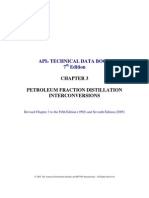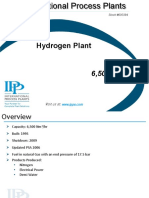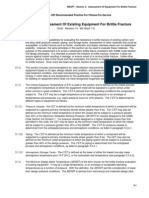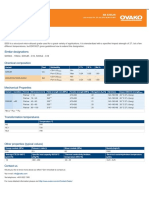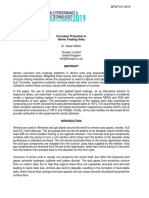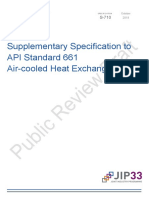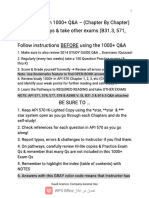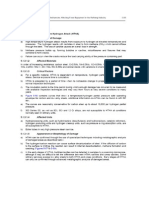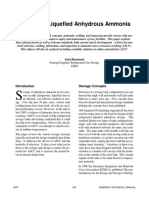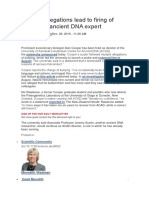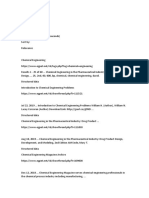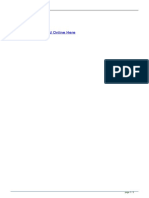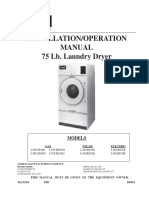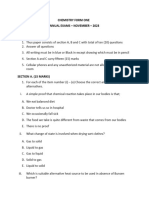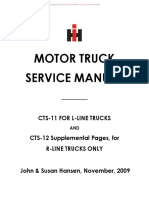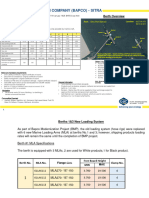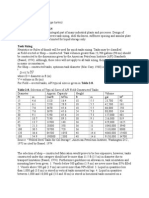API® Tech Data Book 9
Product History
1966 - First edition released
1970 to 1997 – Five new editions based on twelve interim revisions
1996 – Technical Data Committee decides to develop an electronic Data
Book counterpart – RFP process completed in 1997 and contract awarded to
EPCON International
API® Tech Data Book, 9th Edition 1998 – First electronic version was introduced as the API Tech Database –
40% coverage of the Tech Data Book topics
1999 – 13th revision package - the last update to the printed version
2001 – Version 2 electronic – 70% coverage of the Tech Data Book topics
2002 – Version 3 electronic – 100% coverage of the Tech Data Book topics
(distribution of the printed 6th Edition is discontinued)
2005 – The 7th Edition marks the completion of the re-mastering process of
the Data Book into searchable text format and the 4th version of the software
interface (first new, printed Data Book available since 1999).
For the Improved Design and 2007 – The 8th Edition released as the 40th Anniversary Edition
Operation of Petroleum Refineries 2009 – Version 8.1 with all data book updates released.
2013 – Version 9 with all new software components will be released
API® Tech Data Book 9 API® Tech Data Book 9
Current API Technical Data
Technical Overview
Committee Membership
An API Standard - Developed/Maintained under API Funding for over
50+ years. Cal Spencer, Chair (KBR)
Mission Statement: provide a critically reviewed compilation of the physical and
thermodynamic data and correlations that are of most interest to petroleum David Bluck (Invensys)
refiners for process evaluation and equipment design Joel Glassett (BP)
Provides the technical expert’s recommendations on what data and
methods should be employed to accurately predict the phase equilibrium and Jack Heidman (ExxonMobil)
thermo-physical properties of chemical and refining streams. Homy Maerefat (CBI/Lummus)
This information is necessary for the cost effective design of and for the safe
and efficient operation of process units. Patrick Malone (Shell Global Solutions)
Stewardship/Critical Review – API Technical Data Committee Paul Mathias (Fluor)
Over 10,000 copies of the printed Data Book have been sold in the US and
abroad Henry Ren (Chevron)
Unmatched accuracy for key technical data used in the design and operation Greg Cantley (Marathon Petroleum)
of chemical and refining facilities in the 9th Edition:
Hydrocarbon – Water Solubilities Howard Wilson (Phillips 66)
Physical Properties of Sulfur Containing Components Todd Willman (EPCON International, ex-officio)
Petroleum Fraction Characterization
An educational tool in thermodynamics for the practicing Chemical Engineer Duane Brown (API Staff Support)
1
� API® Tech Data Book 9 API® Tech Data Book 9
Technical Coverage API Funded Related Research
Volume I - General Properties and Characterization
Chapter 1 - General Data 1989 to 1995
Chapter 2 - Characterization of Hydrocarbons
Phase equilibrium on Oxygenates (MTBE, TAME, ETBE) in Hydrocarbons and prototype
Chapter 3 - Petroleum Fraction Distillation Interconversions Gasolines
Chapter 4 - Critical Properties $315K
Chapter 5 - Vapor Pressure
1989 to 1994
Chapter 6 – Density
VLE of prototype systems at Hydroprocessing conditions (H 2, NH3, H2S, H2O in
Volume II - Thermal Properties and Phase Equilibria Hydrocarbons/Oils)
Chapter 7 - Thermal Properties $250K
Chapter 8 - Vapor-Liquid Equilibrium K-Values 1989 to 1998
Chapter 9 - Phase Equilibria in Systems Containing Water Crude Oil Characterization Study
Volume III - Surface & Transport Properties and Combustion $750K
Chapter 10 - Surface and Interfacial Tension 1996 to 1997
Chapter 11 - Viscosity Reid Vapor Pressure data on prototype petroleum products and crude oils
Chapter 12 - Thermal Conductivity $50K
Chapter 13 - Diffusivity
Chapter 14 - Combustion
2000 to 2005
Chapter 15 - Adsorption Equilibria Phase equilibrium of sulfur compounds in gasoline/diesel
Chapter 16 – Software Applications $175K
API® Tech Data Book 9 API® Tech Data Book 9
API Funded Data Book Development API Funded Related Research (2)
1959 to 1999 Conducted at Pennsylvania State University
Principal Investigators: Fenske, Braun, Daubert, Danner
Total API funding of $3.5MM 2011 to 2013
Phase equilibrium of Mercury - Light Naphtha systems
2000 to 2013 $20K
Total API funding of $900K+ 2012 to 2013
Core research of $50K-$75K each year Improved correlation for viscosity of Heavy Oils (+1000 ºF NBP)
Development/Maintenance revision handled by $150K
• EPCON International – oversees all software and data revisions
• Sr. Consultant: Costa Tsonopoulos (Exxon, 20 year Technical Data
Committee member, Chairman 1999-2000) Over $2MM in Related Research Funded by API and its
• Membership in DIPPR Members
Over $4MM in Direct Research & Development
Funded by API
2
� API® Tech Data Book 9 API® Tech Data Book 9
API TDB Corporate Licensees Example Data Book Strength
Corporate – Unlimited Use 1. Thermal Conductivity (API Crude Oil Characterization Study in 2000 – closest shown blue)
Bechtel (1999-2009)
BP (1998-2013) Sample: Temp, F Experimental API Tech 8 Simulator 1 Simulator 2 Simulator 3
Chevron (1999-2013) San Joaquin Btu/hr-ft-F Btu/hr-ft-F Btu/hr-ft-F Btu/hr-ft-F Btu/hr-ft-F
Valley Crude
Citgo (1999-2013)
ConocoPhillips (1998-2013) SG=.9483 104 .0694 .0729 .0627 .0975 .0602
Foster Wheeler (1999-2013) BP=696 F 212 .0658 .0684 .0587 .0912 .0564
302 .0626 .0670 .0552 .0858 .0531
KBR (1998-2013)
Marathon (1998-2013)
Phillips 66 (2008-2013) SG=.9872 104 .0747 .0768 .0585 .1019 .0556
BP=926 F 212 .0704 .0721 .0554 .0964 .0527
Shell Oil (1998-2013) 302 .0665 .0681 .0527 .0916 .0501
Over $1MM in Software Development funded by EPCON using Licensing Fees
API® Tech Data Book 9 API® Tech Data Book 9
Common Uses for API Tech Example Data Book Strength
Independent cross-check of process simulator results 2. Kinematic Viscosity (API Crude Oil Characterization Study in 2000 – closest shown blue)
Research and development tool for conceptual design and feasibility studies
User-friendly design tool for engineers who infrequently use simulation
software Sample: Temp, F Experimental API Tech 8 Simulator 1 Simulator 2 Simulator 3
Composite cS cS cS cS cS
Can be used as a basis for guarantees, commodity transfer, etc. as a Petroleum
commonly accepted industry standard Cut
Useful in companies without readily available/timely technical support
through a central engineering group SG=.973 212 81.4 70.5 470.0 76.0 444.6
BP=1127 302 14.8 14.8 115.4 21.1 95.8
Good estimation tool for refineries and operating facilities (allows
consistency with the central office)
Education/Training tool for young engineers and undergraduates in chemical
SG=.9872 158 46.0 30.8 1169.7 41.6 18554
engineering programs
BP=926 F 212 16.8 13.3 373.4 21.4 4185
Low-cost alternative for the consulting engineer to provide highly accurate 302 5.4 5.1 93.9 9.9 556
flash and mixture properties of chemical and petroleum streams
3
� API® Tech Data Book 9 API® Tech Data Book 9
Example Data Book Strength Water – Propane Solubilities
3. Hydrogen Solubility (comparison to experimental data from several sources)
Data Type Water in Propane Propane in Water
System: Temp, F Pressure, Experimental Predicted % deviation
psia (140 Deg.F) (mole%)
Liq.mol.frac. Liq.mol.frac
Hydrogen – 10 822 .04 .0361 -9.75 Experimental Data .184 .0202
n-Butane 40 2390 .111 .110 -.90
75 1130 .062 .0648 4.52
Hydrogen – 100 650 .04 .0373 -7.50 API Solubility Equation .186 .0200
n-Hexane 160 1000 .064 .0684 6.88
Hydrogen – 372.7 726 .0678 .0648 -4.42
n-Decane 372.7 1463.7 .131 .121 -7.63 API-NRTL .186 .0200
Hydrogen - 137.9 348.1 .01247 .0117 -6.17
Cyclohexane 211.7 390.2 .01785 .0168 -5.88
API-SRK-KD .250 .0270
211.7 636.7 .02951 .0276 -6.47
Hydrogen - 320 500 .0175 .0185 5.72
Benzene 320 1500 .0592 .0604 3.43
API® Tech Data Book 9
Example Data Book Strength
4. Mutual Solubilities of Water-Hydrocarbon Systems
Can be Calculated on 3 Platforms in the API Tech Data Book
Direct Solubility Equation (semi-empirical, temperature dependent correlation)
NRTL (Flash/Mixture Calculations)
SRK-Kabadi-Danner (Flash/Mixture Calculations)
The Solubility Equation provides the best fit of the experimental data (i.e. the
correct answer)
NRTL parameters for 100+ hydrocarbons and water have been highly tuned
to fit the experimental data and essentially provide the same results of the
Solubility Equation plus extremely accurate solubility for:
Mixtures versus pure components
Pressures other than Atmospheric
Temperatures other than Ambient
SRK-KD provides reasonable estimates for Water-Hydrocarbon when
accurate NRTL parameters are not available
